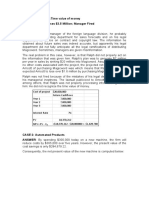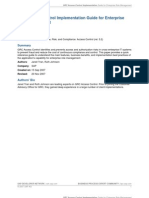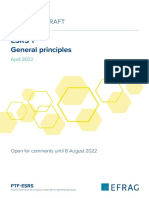Case-1 Questions
Case-1 Questions
Uploaded by
adeshlCopyright:
Available Formats
Case-1 Questions
Case-1 Questions
Uploaded by
adeshlCopyright
Available Formats
Share this document
Did you find this document useful?
Is this content inappropriate?
Copyright:
Available Formats
Case-1 Questions
Case-1 Questions
Uploaded by
adeshlCopyright:
Available Formats
PGP 2012-13 Course: Business Risk management Module: Financial Risks Instructor: B.B.
Chakrabarti
Case: Air Canada Risk Management (IVEY 9B10N037) 1) What were Air Canadas strategies since 2009 to improve financial performance and control of risks? 2) Discuss the sources of risk in Air Canadas business. What strategies are applied for risk mitigation? 3) Do you think that Air Canadas risk management practices are appropriate? If yes, why? If not, why?
ANALYSIS OF THE VARIOUS RISKS TAKEN CARE OF BY AIR CANADA 1.CATASTROPHIC RISK :- Despite flying be the safest form of passenger travel but still aviation insurancewas considered very important because it could generate potential losses to a very high extent evenfrom a single event .A large commercial aircraft was typically insured for $100 million-$250 million andits liability coverage ranged between $1.5 million -$2 billion. 2.OPERATIONAL RISK:-Operational risk had the potential for high frequency given the volume of passengers and flights. To manage these issues the used:-1.All airline equipment required stringent programs of preventative maintenance and safety2.The IT INFRASTRUCTURE had back-up systems and contingency plans in place. 3.HUMAN RESOURCE PLANNING ENSURES ADDITIONAL CAPACITY WAS AVAILABLE IN THE EVENTS OF ADEALY OR SICKNESSNOW ,QUADRANT WISE DESCRIPTION IN RISK MANAGEMENT OF AIR CANADA QUADRANT 1:- IN particular,the board of directors were most concerned with the risk in quadrant 1 thatwere beyond his control. AIR CANADA and the airline industry in general were vulnerable to frequentand dramatic changes in interest rate ,pension reserves,foreign exchange,severe weather,fuel costs andeven their own stock prices.So indirectly, they need to understand that they they were in a big issue asthey were being banged by a lot of problems together which they needed to avoid it but no other optionwith them . QUADRANT:-2 IN GENERAL,the board of directors were being satisfied that AIR CANADA had theinsurance required to quadrant 2 risks as the took the AVIATION INSURANCE at that particular timeQUADRANT3:-NOW in the third quadrant they started undertaking risk .they were now in a position tohedge jet fuel upto a position of 34% for 2010 and 8 % for 2011 .FUEL PRICES WERE a relativelyimportant part in consideration as even a $1 increase in the cost of fuel collectively cost an increase by$425 million in additional operating costs per year .QUADRANT 4 :- IN QUADRANT 4 ,they started using the safety measures as they were already able toreduce risk by the 3rd quadrants,so now they started preventing the reduced risks . INTEREST RATE RISK AND LIQUIDITY RISK :at fixed rate and 40 % at a floating rate .Because the interest rates on debt ws prevailing majorly onfloating
could definitely reach the situation of liquidity risk as stated above they were needed to usethe swaps and interest on cash reserves as well.
FOREIGN EXCHANGE RISK :,but a large portion of it,s expense were in U.S. DOLLARS .To help manage this exchange
You might also like
- Unit ID1 Know - Workplace Health and Safety PrinciplesDocument288 pagesUnit ID1 Know - Workplace Health and Safety Principlesnasir habib100% (6)
- NHS FPX 6008 Assessment 1 Identifying A Local Health Care Economic IssueDocument5 pagesNHS FPX 6008 Assessment 1 Identifying A Local Health Care Economic IssueEmma WatsonNo ratings yet
- F. InventoriesDocument52 pagesF. Inventoriesadelmariaracelle100% (1)
- Final Presentation - AccountingDocument41 pagesFinal Presentation - AccountingViễn Nguyễn KýNo ratings yet
- Tire City IncDocument3 pagesTire City IncAlberto RcNo ratings yet
- Case Analysis - China Big Opportunities, Complicated RisksDocument5 pagesCase Analysis - China Big Opportunities, Complicated RisksMN NihadNo ratings yet
- Southwest Airlines PDFDocument9 pagesSouthwest Airlines PDFYashnaNo ratings yet
- Case Study ValujetDocument5 pagesCase Study Valujetapi-550129088No ratings yet
- Assessing The Goal of Sports ProductsDocument2 pagesAssessing The Goal of Sports ProductsSean Chris ConsonNo ratings yet
- THE EFFECT OF RISK MANAGEMENT ON FINANCIAL PERFORMANCE OF INSURANCE COMPANIES IN KENYA Chapter 1Document20 pagesTHE EFFECT OF RISK MANAGEMENT ON FINANCIAL PERFORMANCE OF INSURANCE COMPANIES IN KENYA Chapter 1Dennis NziokiNo ratings yet
- CH 13Document9 pagesCH 13portia16100% (1)
- Checklist - Audit - ISO 9001-2015Document144 pagesChecklist - Audit - ISO 9001-2015pratomo E T100% (2)
- Aircanada Case StudyDocument4 pagesAircanada Case StudyJashan SidhuNo ratings yet
- A Case Study On Cost Estimation and Pro - Tability Analysis at Continental Airlines PDFDocument21 pagesA Case Study On Cost Estimation and Pro - Tability Analysis at Continental Airlines PDFTangi Simamora0% (1)
- Enron Scndal Reaction PaperDocument1 pageEnron Scndal Reaction PaperHarold AnactaNo ratings yet
- Strama Continental AirlinesDocument4 pagesStrama Continental AirlinesNadine SantiagoNo ratings yet
- Aspen TechnologyDocument18 pagesAspen TechnologySamaresh PaikaraNo ratings yet
- Case Study WordComDocument7 pagesCase Study WordComRaina ClarisaNo ratings yet
- IB Case StudyDocument4 pagesIB Case StudyManisha TripathyNo ratings yet
- Merger & Akuisisi TKMKDocument65 pagesMerger & Akuisisi TKMKArieAnggono100% (1)
- Chapter 5 PPT (To Students)Document48 pagesChapter 5 PPT (To Students)Heidi ChanNo ratings yet
- Application of Economic Concepts-Activity 1Document3 pagesApplication of Economic Concepts-Activity 1Katrina Amore VinaraoNo ratings yet
- Singapore International Airlines - Strategy With Smile PDFDocument19 pagesSingapore International Airlines - Strategy With Smile PDFNikita SinhaNo ratings yet
- Chapter 11 PracticeProblemsDocument5 pagesChapter 11 PracticeProblemsYousry El-FoweyNo ratings yet
- Questions - Delta AirlinesDocument1 pageQuestions - Delta Airlinessaketh6790No ratings yet
- 2017 Acf - Revision1Document15 pages2017 Acf - Revision1Leezel100% (1)
- Case # 1 LEADERSHIP CROSSROADSDocument4 pagesCase # 1 LEADERSHIP CROSSROADSArvil Rodriguez DucusinNo ratings yet
- Holy Angel University Logo TitleDocument71 pagesHoly Angel University Logo TitleRichard Adam SisonNo ratings yet
- Air Canada SwotDocument3 pagesAir Canada SwotKRISHAN SINGHNo ratings yet
- Mylan EpiPen StatementDocument3 pagesMylan EpiPen StatementCBS This MorningNo ratings yet
- Risk Management BoeingDocument7 pagesRisk Management BoeingjonathanguntaraNo ratings yet
- Assignment 3 - Group 3 - Section EDocument6 pagesAssignment 3 - Group 3 - Section ESHUBHAM PRASADNo ratings yet
- Case Analysis Hony, CIFA and Zoomlion (Creating Value and Strategic Choices in A Dynamic Market)Document5 pagesCase Analysis Hony, CIFA and Zoomlion (Creating Value and Strategic Choices in A Dynamic Market)abhinavNo ratings yet
- Case 1 - Brewster Company - Sasot GroupDocument6 pagesCase 1 - Brewster Company - Sasot GroupRobin VenturinaNo ratings yet
- Southwest Airlines Group 2Document20 pagesSouthwest Airlines Group 2junadriann bulaonNo ratings yet
- Resarch Paper On Franchising Business MacobDocument8 pagesResarch Paper On Franchising Business MacobAngelika Capa Reyes100% (1)
- International Cash ManagementDocument28 pagesInternational Cash Managementdadali.enterprise6123100% (1)
- Chapter 2 ResearchDocument19 pagesChapter 2 Researchaliza shakyaNo ratings yet
- Chapter 13 MK 2Document5 pagesChapter 13 MK 2Novelda100% (1)
- Tugas FM FuzzyTronicDocument7 pagesTugas FM FuzzyTronicAnggit Tut PinilihNo ratings yet
- ArabianFoodIndustries Domty InitiationofCoverageOctober2016Document36 pagesArabianFoodIndustries Domty InitiationofCoverageOctober2016nimerahNo ratings yet
- Aquarius Food Industries Inc SwotDocument4 pagesAquarius Food Industries Inc SwotSamael LightbringerNo ratings yet
- PQ, SQ and RP On Petrol Services StationDocument100 pagesPQ, SQ and RP On Petrol Services StationMamerto LegaspiNo ratings yet
- Southern Discomfort Case AnalysisDocument1 pageSouthern Discomfort Case AnalysisYzat Abd100% (1)
- 2016 8 30 EpiPen LetterDocument8 pages2016 8 30 EpiPen LetterTim TiemannNo ratings yet
- Capital MarketDocument27 pagesCapital MarketJoebet DebuyanNo ratings yet
- Pestle Analysis ExampleDocument9 pagesPestle Analysis ExampleDilraj SondhNo ratings yet
- Chapter 5 CaseDocument3 pagesChapter 5 CaseCathlyn AbionNo ratings yet
- Responsibility AccountingDocument41 pagesResponsibility AccountingrkdarakNo ratings yet
- McDonalds Financial AnalysisDocument11 pagesMcDonalds Financial AnalysisHooksA01No ratings yet
- Managerial Accounting-Solutions To Ch05Document4 pagesManagerial Accounting-Solutions To Ch05Mohammed HassanNo ratings yet
- Faris Dzikrur Rahman - 29317008 - Decision Tree AssignmentDocument2 pagesFaris Dzikrur Rahman - 29317008 - Decision Tree AssignmentFaris Dzikrur Rahman100% (1)
- Risk Assessment QuestionnaireDocument1 pageRisk Assessment QuestionnairePhilip Valenta :: [mezcalindo]No ratings yet
- Southwest Case StudyDocument4 pagesSouthwest Case StudyDOUGLASSNo ratings yet
- Financial ManagementDocument3 pagesFinancial Managementgundapola100% (2)
- Figure Eight Island Homeowners' Association, Inc. Case StudyDocument16 pagesFigure Eight Island Homeowners' Association, Inc. Case StudyYoong YingNo ratings yet
- RMontoya SolutaDocument21 pagesRMontoya SolutaTy Best CoonNo ratings yet
- Case 2.2 and 2.5 AnswersDocument4 pagesCase 2.2 and 2.5 AnswersHeni OktaviantiNo ratings yet
- Corporate Strategy - Air IndiaDocument7 pagesCorporate Strategy - Air Indiapavananandmr0% (1)
- Air CanadaDocument12 pagesAir CanadaMonisha Batra100% (1)
- Case Analysis: IR AnadaDocument12 pagesCase Analysis: IR AnadaER ABHISHEK MISHRANo ratings yet
- Coming Through The CloudsDocument36 pagesComing Through The Cloudsקאסטרא אַדריאַןNo ratings yet
- CRITICAL REVIEW of AirlineDocument5 pagesCRITICAL REVIEW of AirlineSakshi PokhriyalNo ratings yet
- KPMG MVO Sector Risk Analysis - EN 2014Document100 pagesKPMG MVO Sector Risk Analysis - EN 2014Anonymous 1ZbeqVESNo ratings yet
- Risk Reduction Strategies For New Entry ExploitationDocument3 pagesRisk Reduction Strategies For New Entry ExploitationSandeep100% (4)
- 2013 Technical GuidanceDocument18 pages2013 Technical Guidanceamman khannaNo ratings yet
- Ecological Framework in Health PromotionDocument55 pagesEcological Framework in Health PromotionBala DOCNo ratings yet
- Research Project-Nirav (K30), Deepesh (K32), Vishnu (K40)Document20 pagesResearch Project-Nirav (K30), Deepesh (K32), Vishnu (K40)Vishnu TiwariNo ratings yet
- SAP GRC Access Control 5.2 Implementation Guide For Enterprise Role ManagementDocument11 pagesSAP GRC Access Control 5.2 Implementation Guide For Enterprise Role ManagementpenguinfootNo ratings yet
- Twou Short IdeaDocument25 pagesTwou Short IdeaAnonymous Ht0MIJNo ratings yet
- A Guide To The COMAHDocument145 pagesA Guide To The COMAHMahmoud ElghayishNo ratings yet
- Essa Chennai Pforr 10mar2021 CleanDocument179 pagesEssa Chennai Pforr 10mar2021 CleanAkshayaNo ratings yet
- ROM HB v. 6 Annexes - ENDocument78 pagesROM HB v. 6 Annexes - ENAlecos KelemenisNo ratings yet
- Risk Assesment 1Document13 pagesRisk Assesment 1Dian Kristina RusmanaNo ratings yet
- BSBLDR602 Appendices and TemplatesDocument18 pagesBSBLDR602 Appendices and TemplatesKate VelardoNo ratings yet
- The Origins and Evolution of Credit Risk Management: RiskhistoryDocument3 pagesThe Origins and Evolution of Credit Risk Management: RiskhistoryjayaNo ratings yet
- KPI and Incident Hazard ReportingDocument31 pagesKPI and Incident Hazard Reportingfaraz shamimNo ratings yet
- Deft Strategy 2022-2024 Version - HO EditsDocument18 pagesDeft Strategy 2022-2024 Version - HO Editsemerald computersNo ratings yet
- 004 - PeiclDocument976 pages004 - PeiclmedeirosjosejusNo ratings yet
- Public Money & ManagementDocument8 pagesPublic Money & ManagementSajmin MilyNo ratings yet
- NOrsock Standard R-002Document186 pagesNOrsock Standard R-002Popovici AlexandruNo ratings yet
- Bahvioral FinanceDocument14 pagesBahvioral FinanceNouman MujahidNo ratings yet
- Yellow 627 Isolation PolicyDocument24 pagesYellow 627 Isolation PolicyPuspita Eka Kurnia SariNo ratings yet
- Lto Ilo 20669Document11 pagesLto Ilo 20669marlynNo ratings yet
- Seemule, M., Sinha, N. and Ndlovu, T. (2017) Comm Bank in BotswanaDocument23 pagesSeemule, M., Sinha, N. and Ndlovu, T. (2017) Comm Bank in BotswanacarltondurrantNo ratings yet
- Ed Esrs 1Document49 pagesEd Esrs 1Jamsari SulaimanNo ratings yet
- NID PreventionDocument18 pagesNID PreventionVeera MarcxNo ratings yet
- Galleon - September 2009 ExposureDocument14 pagesGalleon - September 2009 Exposuremarketfolly.comNo ratings yet
- 15 Punjabi Potato Contract Farming For Pepsi India FormattedDocument17 pages15 Punjabi Potato Contract Farming For Pepsi India FormattedVineet SinghNo ratings yet
- A Detailed Comparison Between AtRisk ModelRisk and Crystal Ball PDFDocument11 pagesA Detailed Comparison Between AtRisk ModelRisk and Crystal Ball PDFkamaraNo ratings yet

























































































